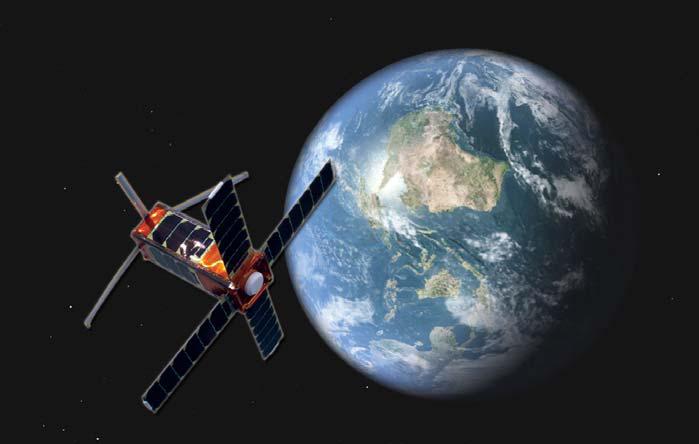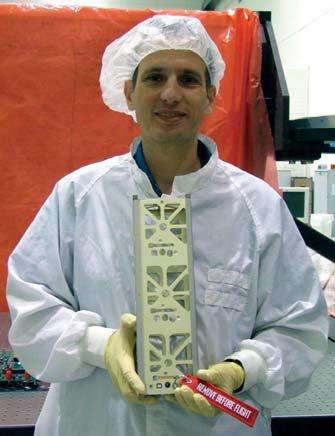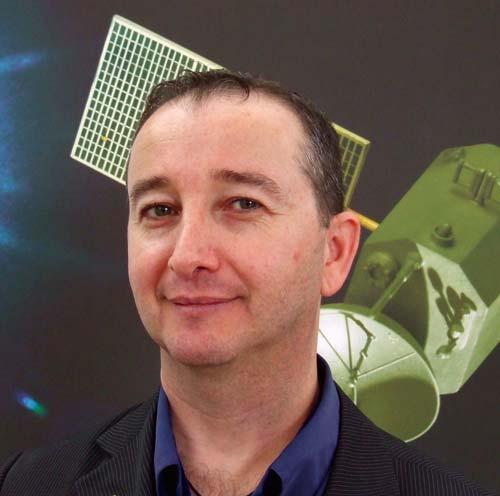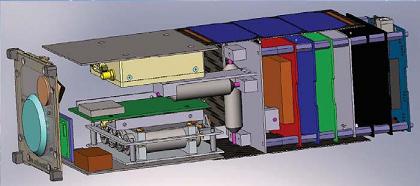At the beginning of 2010, a nano-satellite weighing only 3 kg will be launched into space, developed and produced by the Israeli association INSA. It will serve as a relay station for radio enthusiasts, as a cheap generic laboratory for testing new space components, and will usher in a new era of cooperative satellites in an open source format

The article was published in the latest issue of the WAVETECH magazine
the clash between a defunct Russian communications satellite and an Iridium communications satellite in early February illustrated the space industry's biggest problem: A malfunction during a mission is nearly impossible to fix. In this unusual case the collision ended in a total loss, but even in cases of other failures, sometimes minor on the scale of the Earth, the space mission ends in disaster.
For this reason it is very difficult to integrate new components or innovative technologies in the space industry. Any body operating in space, governmental or commercial, prefers to use components that have been tried and proven in space before installing them on a platform whose launch will cost tens and hundreds of millions of dollars.
new idea Conceived by the Israeli association for small satellites - INSA (Israel Nano Satellite Association) in Israel may change this reality. At the beginning of 2010, the association will launch a new and unusual Israeli satellite into space: a nano-satellite that weighs only 3 kg and which will serve as an available and cheap platform that allows components to be launched into space, tested under real conditions and given Space Proven certification, which will open up the global space market to them.
Satellite on demand
The concept Nanosatellite is not an Israeli invention. Satellites are usually classified into three main groups. Central mini-satellites weighing 100 kg to a ton. Microsatellites weighing from 10 to 100 kg, nanosatellites weighing 1-10 kg, and pico-satellites weighing from 100 grams to 1 kg.
Interest in nanosatellites has increased recently, after China conducted an experiment to destroy a satellite in space in January 2007, and the United States conducted a similar experiment in February 2008. Both experiments pushed the US to increase efforts to provide a rapid response capability. That is, fast launch on demand of small and cheap satellites.
The Israeli satellite does fit this definition: its development costs no more than half a million dollars and the launch expenses are considered insignificant compared to other space projects, but it is designed to achieve civilian goals: developing a "space laboratory" platform for testing off-the-shelf components, developing a new generation of radio enthusiasts in Israel, testing Various telemetry methods and the achievement of educational goals such as the active involvement of students and high school students in a real space project.
Beyond that, the satellite is developed in an open source format, thus bringing revolutionary news to the global space industry. The association opens up the satellite specifications to any body interested in it, in order to create a cooperative community similar to the open source community that created a revolution in the software industry. It also allows radio enthusiasts from all over the world to integrate into the telemetry data reception system and makes it available to them as a global relay station.
Israeli cooperation
The INSA association was established in 2006 by a group of about 15 employees from the Israeli high-tech and space industry from companies such as IAA, Rafael, Space Communications, HP-Indigo and more. The association is supported by the IAA, which allows it to assemble the satellite in the Mabat factory and helps it with partial financing.

Two of the group's leaders, Midad Farinta and Raz Tamir, who work at TAA, told WaveTech about the idea behind the satellite. Farina from the space division of the Mabat plant serves as the group's spokesperson and system engineer for the satellite. He was in the system engineering team of Amos 2 and the chief system engineer of the French Israeli satellite Venus and the communication satellite Amos 3. Dr. Raz Tamir, founder and CEO of INSA, currently serves as the head of the nanosatellites department at the Aerospace Industry's Mabat Space plant.
Tamir: "So far most of the funding has come from the aerospace industry. Part of the land segment is financed by the Herzliya municipality. The cost of the components amounts to about 150 thousand dollars, when the working hours of the members of the association in the IAA facilities are done voluntarily. The satellite will be launched as a piggy back in the launch of a large commercial payload, most likely on an Indian or Russian launcher. The cost of the launch is estimated at about 200 dollars, and today we are trying to find donations to finance the launch."
In many ways, the space industry is already enjoying the fruits of the project. He was able to bring about cooperation between engineers from TEA and Rafael, and following the lessons learned from it, TEA is currently considering an entry into the field of nanosatellites.
Young radio enthusiasts
According to Farinta, the main control station will operate from the science center in Herzliya. This body unites high schools from the area, where the students in the space major headed by Dr. Anna Heller will build on their own a reception system based on commercial products from which the communication circuits have been "stripped". Already today, more than 300 Jewish and Arab students are involved in the association's projects. "Each of them is an asset, and many of them will join the Israeli space industry in the future."
How will radio enthusiasts from around the world connect to the satellite?
Perinta: "Any radio enthusiast in the world will be able to download from our website (www.insasite.com) an exe file that will decode the telemetry from the satellite and allow the data to be sent to us online. From the experience gained from the launch of NASA's Genesat and Cubesat satellites, the cooperation of radio enthusiasts is amazing. The satellite radio enthusiasts are the older, more experienced and established ones. By combining space studies and studies to obtain an amateur license, we are working to change the trend and integrate young people in the field."
"In recent years, few people join radio amateurs and their average age increases every year. However, the new field of female radio amateurs is reviving the community and bringing many young people to it. Soon a class of licensed radio amateurs will be opened at the Science Center in Herzliya, who will communicate with the satellite and inject new blood into the community of amateurs in Israel."
hear the satellite

The enthusiasts will have a real impact on the development of the field and the following satellites. One of the goals of the satellite is to test the effectiveness of the use of different modulation methods: the AFSK (Audio Frequency-Shift Keying) method versus the BPSK (Binary Frequency-Shift Keying) modulation.
AFSK modulation is much more common today among amateur satellites, and especially satellites built by university space studies departments, but its efficiency is less. Its advantage is that it is based on audio frequencies, which are easy to connect to the audio input of any transmitter and transmit them towards the earth. Something that allows you to "hear" the satellite signals. On the other hand, BPSK modulation requires "analysis" of the transmitter and also the use of an All-Mode receiver, but its advantage is in providing a more reliable communication channel.
Tamir: "The community of radio enthusiasts will be able to test both methods and help us formulate a decision which one is better for a nanosatellite."
How will the satellite function as a space laboratory?
"The space environment is characterized by space radiation, vacuum, extreme temperature cycles and strong shocks during the launch phase. The laboratories located on the surface of the ground provide no more than two parameters at the same time, so it is very difficult to test new space components. The result is that in the 30 years of the space industry, the failure rate of new systems has hardly changed.
"A space laboratory like the one we offer is a distinct commercial interest of component manufacturers, because today the price of receiving the Space Proven (or Space Heritage) badge amounts to at least one million dollars. The laboratory is generic and allows each manufacturer to define the telemetry it needs to approve the component, and we integrate it into the telemetry of the satellite."
A laboratory in space
Already in the first launch, the satellite includes components for testing function in space. Among them: an atomic clock by the company Acubit from Mehr Khotsavim in Jerusalem, a GPS device by the company BAE Israel (formerly Rocar), and a high-energy lithium-ion battery by the British company ABSL, which is considered one of the most important battery manufacturers in the space industry.
Raz Tamir explains that the satellite's ability to serve as a generic laboratory is based on the system's definition as a standard interface in the IIC communication protocol, and as a system with a 104-pin PC104 form factor. "In addition, the satellite has an interface card that speaks to most accepted standards and a protocol conversion card that allows us to 'talk' to any unit that is small enough to enter the satellite.
"The size in this case is not a significant limitation, because our test shows that more than 70% of all failures in space components in the world are of components smaller than 10 X 10 cm.
"Such a laboratory also provides an important service to satellite manufacturers, not only to component suppliers. The manufacturers face the difficulty of obtaining components previously approved for use in space, and in the meantime their production has been stopped and they have left the market. Among the beneficiaries, of course, is the Israeli space industry, which will gain the ability to develop new components and approve them for use at a reasonable cost.
"At the launch we will also test systems that are an integral part of the platform. For example, magnetometers from the Erazim company, which until today have not been launched into space. The magnetometers create electric fields in three axes, which make it possible to stabilize the satellite in relation to the Earth's magnetic field."
Open source
A fascinating and unique topic for the Israeli satellite is the idea of an open source satellite. Until today, the space industry operated under strict rules of secrecy. Except in distinct scientific projects, every body or company tends to keep its technological cards very close to its chest. They provide third-party customers with components, platforms or services, but do not share them with the knowledge that led to their development.
The INSA association decided to change the rules. It publishes on its website the technical information of the satellite structure, the principles of operation, the technical considerations and the information about the algorithms. "We believe that the open source approach allows cooperation between many parties, and will eventually lead to the growth of a completely new service industry", explains Tamir.
The idea is already causing enthusiasm in the world. "Our website receives hits from all over the world, including from countries like Iran and Iraq. We received requests from Romania and Ukraine to assist them in nanosatellite planning, and made the information available to them in exchange for credit in their nanosatellite programs. The space community also contributes a lot of knowledge to us, and we work in collaboration with space officials from Scotland, the Netherlands and other countries.
"We believe that the nanosatellites are a community in itself," clarifies Tamir, who initiated the nanosatellite symposium as part of the Ilan Ramon Space Conference held at the Air Force Base in Herzliya in January of this year.
A satellite the size of a shoebox

The first satellite, InKlajn1 (named after the Israeli space pioneer Dr. Marcel Klein), is planned to move in a solar orbit (heliosynchronous) at an altitude of 650 km, and circle the Earth every 90 minutes. Unlike other satellites, it does not contain navigation engines, and its movement will be controlled by three magneto-turkers.
To save weight, the designers also dispensed with standard star detection and sun detection systems. Instead, the satellite will use the solar panels as an array of sensors that allows it to identify where the sun is by analyzing the power of the electricity they produce.
In total, the platform includes four central sensing and control systems: a three-axis magnetometer to measure the Earth's magnetic flux. A three-axis gyroscope based on MEMS technology for measuring changes in the satellite's directional acceleration. The array of solar cells that is also used as a sensor to measure the direction of the sun and three magnets to create a twisting moment (Magneto-torquers) in three axes with respect to the Earth's magnetic field, to control the position of the satellite and its angle of inclination.
Inside the platform are installed two different computers that back each other up. A computer based on TI's MSP430 processor, which is a 16-bit low-power RISC processor that can connect directly to analog peripherals, and a computer based on LEON3 processor, which is a 32-bit Aeroflex Gaisler processor based on the SPARC V8 architecture.
Each of the computers can function as a master processor operating at a frequency of approximately 7.3 MHz. Both operate using the same software code and are very compact: up to only 10 Kb. The main software functions include: reading the telemetry data from all the units, evaluating the satellite's position by running algorithms that calculate its position in relation to the sun and the Earth's magnetic field, controlling the temperature of the various satellite units and evaluating the satellite's condition: checking compatibility between the logical operations carried out on the computer and the information on the satellite's position .
The planning and construction are based on maximum saving of resources, including planning resources. All systems are implemented in standard PCI104 cards connected to each other in a tight bond, as is customary in the field of rockets. In addition, the platform includes a corner reflector (Corner Reflector), for returning SLR (Satellite Laser Ranging) signals launched from the ground. These signals help determine with great precision the altitude, speed and direction of the satellite's movement, and are also used as control signals for testing the experimental GPS system that will be installed in it.
The association calls on everyone who holds the issue of space close to their heart and feels they have something to contribute, to join it.
The association's website
Contact
The training of young radio amateurs and the construction of the ground station in Herzliya are done in collaboration with Association of radio enthusiasts in Israel.

6 תגובות
If you were really there, you probably wouldn't say that... because all the children there are enjoying themselves and succeeding and gaining a lot of knowledge.
So... her life in a movie where children are treated badly.
Especially since their enthusiasm is what motivates the students' work for the association.
I was there and I know it's not normal
Listen to me…….. You are killing yourselves and the poor children
On the other hand, satellites testing such technologies will add to the amount of orbital junk and endanger satellites that cost hundreds of millions of dollars.
I would put the science site on a satellite. Unusual business.